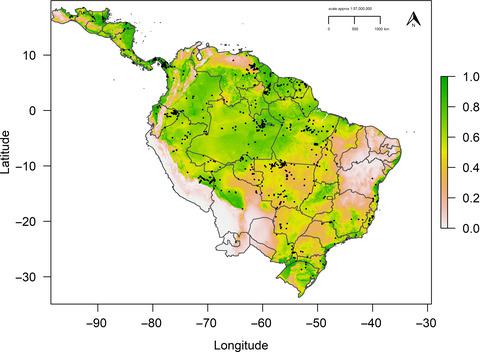当前位置:
X-MOL 学术
›
Ecol. Evol.
›
论文详情
Our official English website, www.x-mol.net, welcomes your
feedback! (Note: you will need to create a separate account there.)
Geographic range estimates and environmental requirements for the harpy eagle derived from spatial models of current and past distribution
Ecology and Evolution ( IF 2.3 ) Pub Date : 2020-12-15 , DOI: 10.1002/ece3.7068 Luke J Sutton 1, 2 , David L Anderson 2 , Miguel Franco 1 , Christopher J W McClure 2 , Everton B P Miranda 3 , F Hernán Vargas 2 , José de J Vargas González 2 , Robert Puschendorf 1
Ecology and Evolution ( IF 2.3 ) Pub Date : 2020-12-15 , DOI: 10.1002/ece3.7068 Luke J Sutton 1, 2 , David L Anderson 2 , Miguel Franco 1 , Christopher J W McClure 2 , Everton B P Miranda 3 , F Hernán Vargas 2 , José de J Vargas González 2 , Robert Puschendorf 1
Affiliation

|
Understanding species–environment relationships is key to defining the spatial structure of species distributions and develop effective conservation plans. However, for many species, this baseline information does not exist. With reliable presence data, spatial models that predict geographic ranges and identify environmental processes regulating distribution are a cost‐effective and rapid method to achieve this. Yet these spatial models are lacking for many rare and threatened species, particularly in tropical regions. The harpy eagle (Harpia harpyja) is a Neotropical forest raptor of conservation concern with a continental distribution across lowland tropical forests in Central and South America. Currently, the harpy eagle faces threats from habitat loss and persecution and is categorized as Near‐Threatened by the International Union for the Conservation of Nature (IUCN). Within a point process modeling (PPM) framework, we use presence‐only occurrences with climatic and topographical predictors to estimate current and past distributions and define environmental requirements using Ecological Niche Factor Analysis. The current PPM prediction had high calibration accuracy (Continuous Boyce Index = 0.838) and was robust to null expectations (pROC ratio = 1.407). Three predictors contributed 96% to the PPM prediction, with Climatic Moisture Index the most important (72.1%), followed by minimum temperature of the warmest month (15.6%) and Terrain Roughness Index (8.3%). Assessing distribution in environmental space confirmed the same predictors explaining distribution, along with precipitation in the wettest month. Our reclassified binary model estimated a current range size 11% smaller than the current IUCN range polygon. Paleoclimatic projections combined with the current model predicted stable climatic refugia in the central Amazon, Guyana, eastern Colombia, and Panama. We propose a data‐driven geographic range to complement the current IUCN range estimate and that despite its continental distribution, this tropical forest raptor is highly specialized to specific environmental requirements.
中文翻译:

根据当前和过去分布的空间模型得出角雕的地理范围估计和环境要求
了解物种与环境的关系是定义物种分布的空间结构和制定有效的保护计划的关键。然而,对于许多物种来说,这种基线信息并不存在。有了可靠的存在数据,预测地理范围并识别调节分布的环境过程的空间模型是实现这一目标的一种经济有效且快速的方法。然而,许多稀有和受威胁物种缺乏这些空间模型,特别是在热带地区。角雕( Harpia harpyja )是一种受保护的新热带森林猛禽,大陆分布于中美洲和南美洲的低地热带森林。目前,角雕面临着栖息地丧失和迫害的威胁,被国际自然保护联盟(IUCN)列为近危物种。在点过程建模(PPM)框架内,我们使用仅存在的事件以及气候和地形预测因子来估计当前和过去的分布,并使用生态位因子分析来定义环境要求。当前的 PPM 预测具有较高的校准精度(连续博伊斯指数 = 0.838),并且对零期望具有鲁棒性(pROC 比率 = 1.407)。三个预测因子对 PPM 预测贡献了 96%,其中气候湿度指数最重要(72.1%),其次是最热月最低气温(15.6%)和地形粗糙度指数(8.3%)。评估环境空间的分布证实了解释分布的相同预测因子以及最湿月份的降水量。我们重新分类的二元模型估计当前范围大小比当前 IUCN 范围多边形小 11%。 古气候预测与当前模型相结合,预测了亚马逊中部、圭亚那、哥伦比亚东部和巴拿马的稳定气候避难所。我们提出了一个数据驱动的地理范围来补充当前的 IUCN 范围估计,尽管这种热带森林猛禽分布在大陆,但它对于特定的环境要求是高度专业化的。
更新日期:2021-01-08
中文翻译:

根据当前和过去分布的空间模型得出角雕的地理范围估计和环境要求
了解物种与环境的关系是定义物种分布的空间结构和制定有效的保护计划的关键。然而,对于许多物种来说,这种基线信息并不存在。有了可靠的存在数据,预测地理范围并识别调节分布的环境过程的空间模型是实现这一目标的一种经济有效且快速的方法。然而,许多稀有和受威胁物种缺乏这些空间模型,特别是在热带地区。角雕( Harpia harpyja )是一种受保护的新热带森林猛禽,大陆分布于中美洲和南美洲的低地热带森林。目前,角雕面临着栖息地丧失和迫害的威胁,被国际自然保护联盟(IUCN)列为近危物种。在点过程建模(PPM)框架内,我们使用仅存在的事件以及气候和地形预测因子来估计当前和过去的分布,并使用生态位因子分析来定义环境要求。当前的 PPM 预测具有较高的校准精度(连续博伊斯指数 = 0.838),并且对零期望具有鲁棒性(pROC 比率 = 1.407)。三个预测因子对 PPM 预测贡献了 96%,其中气候湿度指数最重要(72.1%),其次是最热月最低气温(15.6%)和地形粗糙度指数(8.3%)。评估环境空间的分布证实了解释分布的相同预测因子以及最湿月份的降水量。我们重新分类的二元模型估计当前范围大小比当前 IUCN 范围多边形小 11%。 古气候预测与当前模型相结合,预测了亚马逊中部、圭亚那、哥伦比亚东部和巴拿马的稳定气候避难所。我们提出了一个数据驱动的地理范围来补充当前的 IUCN 范围估计,尽管这种热带森林猛禽分布在大陆,但它对于特定的环境要求是高度专业化的。











































 京公网安备 11010802027423号
京公网安备 11010802027423号